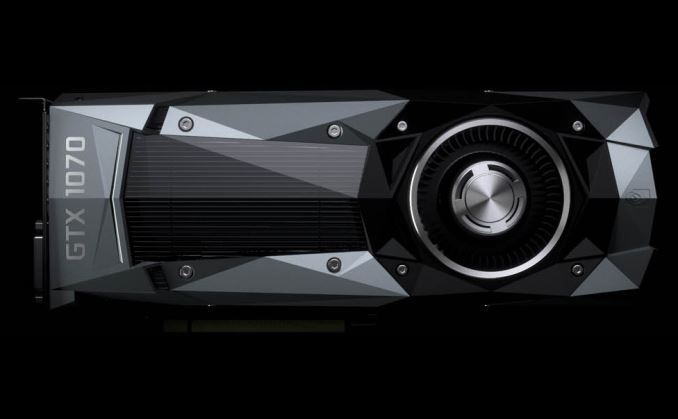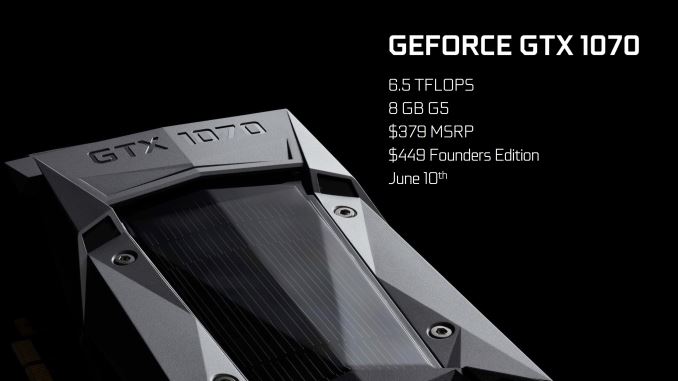NVIDIA Posts Full GeForce GTX 1070 Specifications: 1920 CUDA Cores Boosting to 1.68GHz
by Ryan Smith on May 18, 2016 10:15 PM EST
Back when NVIDIA first announced the GeForce GTX 1080 earlier this month, they also briefly announced that the GTX 1070 would be following it. The GTX 1070 would follow the GTX 1080 by two weeks, and presumably to keep attention focused on the GTX 1080 at first, NVIDIA did not initially reveal the full specifications for the card. Now with the GTX 1080 performance embargo behind them – though cards don’t go on sale for another week and a half – NVIDIA has posted the full GTX 1070 specifications over on GeForce.com.
| NVIDIA GPU Specification Comparison | ||||||
| GTX 1080 | GTX 1070 | GTX 970 | GTX 770 | |||
| CUDA Cores | 2560 | 1920 | 1664 | 1536 | ||
| Texture Units | 160 | 120 | 104 | 128 | ||
| ROPs | 64 | 64 | 56 | 32 | ||
| Core Clock | 1607MHz | 1506MHz | 1050MHz | 1046MHz | ||
| Boost Clock | 1733MHz | 1683MHz | 1178MHz | 1085MHz | ||
| TFLOPs (FMA) | 8.9 TFLOPs | 6.5 TFLOPs | 3.9 TFLOPs | 3.3 TFLOPs | ||
| Memory Clock | 10Gbps GDDR5X | 8Gbps GDDR5 | 7Gbps GDDR5 | 7Gbps GDDR5 | ||
| Memory Bus Width | 256-bit | 256-bit | 256-bit | 256-bit | ||
| VRAM | 8GB | 8GB | 4GB | 2GB | ||
| FP64 | 1/32 | 1/32 | 1/32 | 1/24 | ||
| TDP | 180W | 150W | 145W | 230W | ||
| GPU | GP104 | GP104 | GM204 | GK104 | ||
| Transistor Count | 7.2B | 7.2B | 5.2B | 3.5B | ||
| Manufacturing Process | TSMC 16nm | TSMC 16nm | TSMC 28nm | TSMC 28nm | ||
| Launch Date | 05/27/2016 | 06/10/2016 | 09/18/14 | 05/30/13 | ||
| Launch Price | MSRP: $599 Founders $699 |
MSRP: $379 Founders $449 |
$329 | $399 | ||
Previously disclosed at 6.5 TFLOPs of compute performance, we now know how NVIDIA is getting there. 15 of 20 SMs will be enabled on this part, representing 1920 CUDA cores. Clockspeeds are also slightly lower than GTX 1080, coming in at 1506MHz for the base clock and 1683MHz for the boost clock. Overall this puts GTX 1070’s rated shader/texture/geometry performance at 73% that of GTX 1080’s, and is a bit wider of a gap than it was for the comparable GTX 900 series cards.
However on the memory and ROP side of matters, the two cards will be much closer. The GTX 1070 is not shipping with any ROPs or memory controller channels disabled – GTX 970 style or otherwise – and as a result it retains GP104’s full 64 ROP backend. Overall memory bandwidth is 20% lower, however, as the GDDR5X of GTX 1080 has been replaced with standard GDDR5. Interestingly though, NVIDIA is using 8Gbps GDDR5 here, a first for any video card. This does keep the gap lower than it otherwise would have been had they used more common memory speeds (e.g. 7Gbps) so it will be interesting to see how well 8Gbps GDDR5 can keep up with the cut-down GTX 1070. 64 ROPs may find it hard to be fed, but there will also be less pressure being put on the memory subsystem by the SMs.
Meanwhile as is usually the case for x70 cards, GTX 1070 will have a lower power draw than its fully enabled sibling, with a shipping TDP of 150W. Notably, the difference between the GTX 1080 and GTX 1070 is larger than it was for the 900 series – where it was 20W – so we’re going to have to see if GTX 1070 ends up being TDP limited more often than GTX 1080 is. In that sense TDP is somewhat arbitrary – its purpose is to set a maximum power consumption for cooling and power delivery purposes – and I’m not surprised that NVIDIA wants to stay at 150W or less for the x70 series after the success that was the GTX 970.
Like the GTX 1080, the GTX 1070 will be launching in two configurations. The base configuration is starts at $379 and will feature (semi) custom partner designs. Meanwhile as previously disclosed, NVIDIA will be offering a Founders Edition version of this card as well. The Founders Edition card will be priced at $449 – a $70 premium – and will be available on day one, whereas this is not guaranteed to be the case for custom cards.
The GTX 1070 Founders Edition card will retain the basic stylings of the GTX 1080, including NVIDIA’s new angular shroud. However I have received confirmation that as this is a lower TDP card, it will not get the GTX 1080’s vapor chamber cooler. Instead it will use an integrated heatpipe cooler similar to what the reference GTX 980 used.











137 Comments
View All Comments
ggathagan - Thursday, May 19, 2016 - link
The company restructuring and additional personnel required is usually why companies such as NVIDIA don't sell direct to the end-user.There's a whole host of advantages to avoiding retail business, from their perspective.
just4U - Thursday, May 19, 2016 - link
To be fair.. if it's using the nifty stock coolers from their higher end cards it will keep it's value... and be considered a selling point.JonnyDough - Friday, May 20, 2016 - link
Now if Nvidia were only to pay their janitors like their stockholders your statement would ring true. Capitalism itself is arguably the problem. Debt slave society anyone?Fusion3RB - Sunday, May 22, 2016 - link
Spot on.Codex77 - Thursday, June 23, 2016 - link
NET profits for Nvidia were $1.26bn for the last quarter alone. That's 'net', meaning after business expenses, including R&D, depreciation etc.grant3 - Thursday, May 19, 2016 - link
People who pay extra for their cards are subsidizing everyone else who waits and buys the cheaper ones later.You're cutting off your nose to spite your face!
close - Thursday, May 19, 2016 - link
Gouge is EXACTLY the term to describe this as it perfectly fits the definition of overcharging. \but maybe you can cut it out with the obvious exaggerations trying to devalue a valid point by associating it with outrageous comparisons that only you are thinking of.Now you're free to get swindled all day long if that's your hobby. But stop trying to make those who point this out look like the bad guys.
hbsource - Thursday, May 19, 2016 - link
I'm really not sure this is price gouging. Nvidia developed and released this product. They're a private company. They can charge whatever they like.I live in the UK and I have literally never heard the term 'price gouging' applied to a product or service. I don't actually think it exists as a concept. It's just supply and demand.
BurntMyBacon - Thursday, May 19, 2016 - link
@hbsource: "I live in the UK and I have literally never heard the term 'price gouging' applied to a product or service. I don't actually think it exists as a concept. It's just supply and demand."It does exist as a concept and is pretty well defined. However, as you seem to suspect, it is a concept that describes a more extreme case of limited supply and high demand.
close - Thursday, May 19, 2016 - link
"Price gouging is a pejorative term referring to when a seller spikes the prices of goods, services or commodities to a level much higher than is considered reasonable or fair, and is considered exploitative, potentially to an unethical extent."Nobody says they can't do it. But when they do sell the product at a higher price than considered reasonable by consumers it's called price gouging. This is based on the fact that Nvidia is enjoying temporary exclusivity and the lack of proper competition makes it even more apparent.
I guess you'll see this when the price drops once other vendors show up with their own take on the 1080.